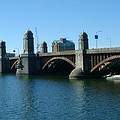 儘管2006年春天美國麻薩諸塞州因不尋常降雨而產生大流量的逕流,查理斯河下游水質似乎未受太大影響,甚至從環保署的評比中獲得B+的亮眼成績。環保署依據2006年查理斯河中帶菌量的檢測結果,評定出這個前所未有的佳績,讓下游再次成為划船與游泳等休憩的好去處。然而,大量的營養物質隨著雨水逕流注入河中,成為潛藏在查理斯河的另一項隱憂。
儘管2006年春天美國麻薩諸塞州因不尋常降雨而產生大流量的逕流,查理斯河下游水質似乎未受太大影響,甚至從環保署的評比中獲得B+的亮眼成績。環保署依據2006年查理斯河中帶菌量的檢測結果,評定出這個前所未有的佳績,讓下游再次成為划船與游泳等休憩的好去處。然而,大量的營養物質隨著雨水逕流注入河中,成為潛藏在查理斯河的另一項隱憂。
在環保署與麻州水利局共同的努力下,2006年排入河中的污水總量已明顯減少,並且預估在未來8年內污水排放量將逐年遞減。負責查理斯河下游的市政當局持續降低雨水排水管中的污水流量,光是2006年平均每日可減少7,500加侖的污水。而這些種種努力已成功提升查理斯河的親水性。
鑒於都市化水準日益提高的同時,非滲透性土地面積也隨之擴展,查理斯河下游流域的土壤早已喪失吸收雨水和過濾逕流雜質的天然能力。不過,這個清理計劃已規劃如何提升查理斯河的休憩功用,以及再造河域健全的生態,屆時所有生物皆能從中受益。
Despite the unusually high amount runoff due to rainfall in Massachusetts during the spring of 2006, the Lower Charles River has attained its highest-ever grade from the U.S. EPA, a B+. The grade reflects the river meets boating and swimming standards during the previous calendar year and is based on measurements of bacteria levels in the water. However, another potentially serious problem has gotten worse - elevated levels of nutrients are entering the Charles River in stormwater runoff.
Under a settlement between the EPA and the Massachusetts Water Resources Authority last year, sewage discharges to the river declined in 2006, and are expected to continue declining for the next eight years. The municipalities of the lower Charles continued to chip away at sewage flows from stormwater pipes, eliminating 7,500 gallons per day during 2006. All these efforts have resulted in a more swimmable Charles River.
Given the level of urbanization and the extent of impervious land cover, the Lower Charles River's watershed has lost much of its natural capacity to absorb rainfall and remove pollutants by filtering the runoff. This cleanup plan charts a path for enhancing recreational opportunities and restoring ecological health to the river so all may continue to enjoy it.



